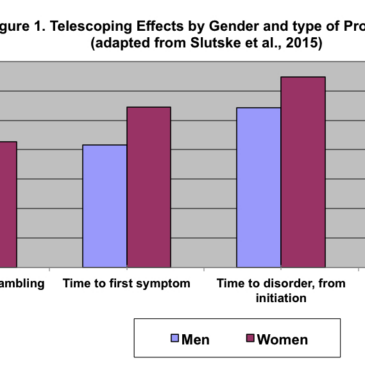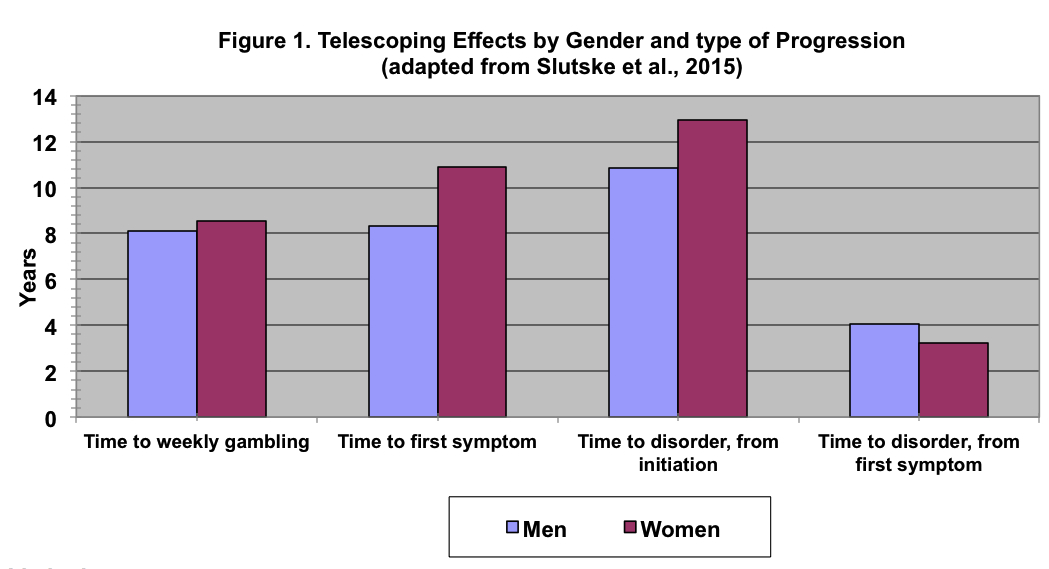Alcohol and gambling research has suggested that men and women progress to addictive behavior at different paces, with women progressing more quickly from initiation to disorder (i.e., the telescoping effect; e.g., Tavares et al., 2001). However, the clinical populations from which researchers have drawn these conclusions are not likely to be representative of people who develop of problems, generally, due to the infrequency with which individuals seek help (Slutske, 2006). This week, as part of our Special Series on Gambling Disorders, The WAGER reviews a study that addresses this possibility by examining the telescoping effect for gambling among a large community sample (Slutske et al., 2015).
Method
- The researchers completed a secondary data analysis of 4,764 members of the Australian Twin Registry Cohort II (Slutske, et al., 2009).
- Among other factors not reported here, cohort members provided information related to gambling initiation (e.g., age at first time gambling), activities on which they gambled weekly for at least 6 months, the age at which they began gambling , age of onset of gambling-related problems, and history of psychiatric disorder.
- The authors used Cox proportional hazard models to examine gender differences in various types of gambling progression.
Results
- Men started gambling earlier (mean age = 17.23) then women (mean age = 18.26).
- As shown in the Figure, compared with women, men progressed more quickly from initiation to weekly gambling, first gambling disorder symptom, and gambling disorder.
- Men and women did not differ in progression to disorder from the age at which they experienced their first gambling-related symptom.
- The study relied upon self-reported gambling information, which is subject to memory, self-presentation, and other biases.
- Another important aspect of the telescoping effect is the time it takes people to seek help for their problems. However, this study used a community sample rather than a help-seeking sample, so there was no measurement of this aspect.
Conclusion
The pathway to gambling-related problems is different for men and women; however, it might be different from anticipated in previous studies. The current work suggests that the progression toward gambling-related problems is accelerated for men compared to women. In contrast, most treatment samples have found the reverse. This work provides evidence that prevention interventions aimed at the general population and treatment interventions aimed at help seekers might need to take into consideration these different developmental pathways in order to best help men and women avoid or curtail gambling-related problems.
– Debi LaPlante
What do you think? Please use the comment link below to provide feedback on this article.
References
Slutske, W. S. (2006). Natural recovery and treatment-seeking in pathological gambling: results of two US national surveys. American Journal of Psychiatry, 163: 297–302.
Slutske, W. S., Meier M. H., Zhu G., Statham D. J., Blaszczynski A., Martin N. G. (2009). The Australian twin study of gambling (OZ-GAM): rationale, sample description, predictors of participation, and a first look at sources of individual differences in gambling involvement. Twin Research & Human Genetics,12: 63–78.
Slutske, W. S., Piasecki, T. M., Deutsch, A. R., Statham, D. J., & Martin, N. G. (2015). Telescoping and gender differences in the time course of disordered gambling: evidence from a general population sample. Addiction, 110, 144-151.
Tavares, H., Zilberman M. L., Beites F. J., Gentil V. (2001). Gender differences in gambling progression. Journal of Gambling Studies, 17: 151–9.





